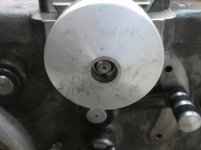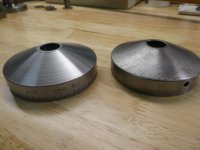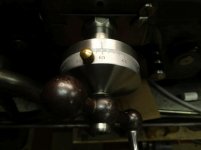I have been collecting parts to do a swap to a large dial on my cross feed and thought I was all set when I saw a 14 1/2 large dial for sale on ebay recently. After checking my books I thought I was in the clear to use it since the parts I got were the same for a 14 1/2 and a 16 but not so fast!
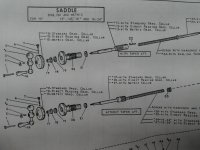
The assembly I got was from a non-taper attachment equipped machine and mine has the taper attachment so I knew there would be some differences but I missed that my detail #11,12,13 was going to end up being too short with the thicker large dials and extended #20 on there (from the above diagram).
It looks like I "may" be able to make an extension sleeve and integrate detail #18 into the sleeve so that it's stronger but I'm in a place I didn't expect so it's best to see what you guys know or have done if you encountered this before.
The old and new detail #20
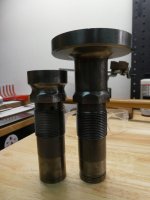
The array of parts I have acquired. I have a diameter reading and a radius dial, and two thrust bearing and washer sets from the newly acquired 14 1/2 non taper attached lathe.

Here you can see where I fall short considering I need room for my crank handle!


no room!!!
Are there any words of wisdom or pointers to get the rest of the way? Thanks. It looks like part #11,12,13 is different lengths between a standard dial and large dial but I don't seem to have that documentation. I'm pretty sure I could make a threaded extension but before I do I want to see what you guys say (or maybe have done if you encountered this)
Cheers

The assembly I got was from a non-taper attachment equipped machine and mine has the taper attachment so I knew there would be some differences but I missed that my detail #11,12,13 was going to end up being too short with the thicker large dials and extended #20 on there (from the above diagram).
It looks like I "may" be able to make an extension sleeve and integrate detail #18 into the sleeve so that it's stronger but I'm in a place I didn't expect so it's best to see what you guys know or have done if you encountered this before.
The old and new detail #20

The array of parts I have acquired. I have a diameter reading and a radius dial, and two thrust bearing and washer sets from the newly acquired 14 1/2 non taper attached lathe.

Here you can see where I fall short considering I need room for my crank handle!


no room!!!
Are there any words of wisdom or pointers to get the rest of the way? Thanks. It looks like part #11,12,13 is different lengths between a standard dial and large dial but I don't seem to have that documentation. I'm pretty sure I could make a threaded extension but before I do I want to see what you guys say (or maybe have done if you encountered this)
Cheers




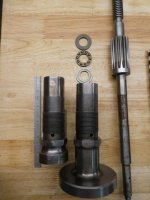
 The gear teeth look super wide on CF. Can put anywhere right ? HA
The gear teeth look super wide on CF. Can put anywhere right ? HA
